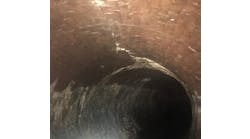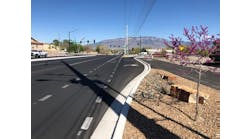What is the cost of traffic disruption? In the San Francisco Bay area, the cost is staggering. Highway 101 (the Bayshore Freeway) is an important north-south traffic artery connecting San Jose with Palo Alto and the San Francisco Bay area. Tens of thousands of vehicles use the Bayshore Freeway every day. Shutting it down for highway repairs would create numerous detours and monumental traffic congestion.
One of the busiest sections of Highway 101 is in San Jose between I-880 and I-680. It was in this section of the highway that the California Department of Transportation (Caltrans) discovered sags in the freeway pavement. Upon closer inspection, they discovered broken, leaking drainage pipes beneath the 10-lane cross section of highway pavement and the highway shoulder. Leaky pipes under roadways are a serious problem. They create soil voids and roadbed deterioration that can lead to sinkholes and, eventually, large potholes or street cave-ins. Unless the leaking pipes are repaired, the problem will only get worse. Delaying the repairs would create more extensive, disruptive and costly maintenance and roadbed replacement.
The cost to dig up and replace the damaged drainage pipes under Highway 101 would have been extremely expensive, costing more than a million dollars. However, the repair expenses were only part of the cost equation. The greater expense would have been to the Bay-area economy, as thousands of commuters and hundreds of businesses would have been disrupted for several weeks. Shutting down the freeway was literally a last resort when Caltrans considered repair options.
Expanding on it
With dig-and-replace repair an unacceptable alternative, Caltrans began examining other repair methods. Several trenchless technologies were considered as options, but which would be best for this application? There are cured-in-place (CIP) technologies that are effective, but using them creates ancillary problems. Most CIP pipe methods require a water source, which is not always readily available near a freeway. Following installation, the water, which is now contaminated with resin by-products, has to be treated before it can be disposed of. Thus, the water issue alone made CIP pipe a less desirable alternative.
This water issue led Caltrans to consider another trenchless technology—Rib Loc Expanda Pipe. Caltrans had used the pipe on an earlier project and found it to be fast, versatile and cost effective. RePipe Inc., Ontario, Calif., performed the previous installation. RePipe is affiliated with Detroit-based Inland Pipe Rehabilitation, a national leader in trenchless pipe reconstruction.
The pipe lining process involves a single strip of pipe-grade PVC, which is spirally wound into the existing pipeline via a patented winding machine that is positioned in the base of an existing manhole or access chamber. The edges of the strip interlock as it winds to form a continuous watertight liner inside the host pipe. When first inserted, the new pipe liner is smaller than the host pipe, but a patented process is used to radially expand the liner to fit tightly against the host pipe. With this option there is a minimal loss of cross-sectional area of the pipe that is offset by the reduction of the “N” number, the coefficient of friction. The result is a liner of high strength with no ripples or wrinkles and typically with great hydraulic capacity. The pipe can be used to structurally rehabilitate brick, concrete, glass-reinforced plastic or corrugated metal sewers and storm-water pipes from 6 to 30 in. in diameter.
Not a bother
Caltrans awarded the general contract to Maggiora Brothers Drilling Inc., Watsonville, Calif. RePipe Inc. was again selected to perform the pipe liner installation.
The traffic flow on Highway 101 made it necessary to perform the installation during nighttime hours, typically between 9 p.m. and 5 a.m. Ronald Albers of Maggiora Brothers, under the direction of the Caltrans staff, managed much of the logistics of the project. They did an admirable job of scheduling the various work crews and agencies that were involved in this project.
Two reinforced concrete pipes were repaired by RePipe using the Expanda technology. The longest was an 18-in. pipe that extends 162 ft under Highway 101. One of Caltrans’ concerns with this pipe was a gaping 8-in. hole in the pipe that was spewing water with a force equal to a 15-ft water head. The pipe easily spanned the hole and eliminated the massive leak. The other pipe was a 30-in. line. Together, the two repairs covered more than 230 linear ft. The liner installation took less than 10 hours to complete. Dig-and-replace methods would have taken at least three weeks and shut down the roadway for days.
The cost of the project was less than $200,000, which is insignificant when compared with the cost in dollars and disruption that an excavate-and-replace job would have cost, not to mention the unthinkable logistical nightmare of freeway closure. Site disruption was minimal, and most commuters never knew that work was going on below the freeway.
Caltrans received great support from Chevalier Pipe Technologies, the company that makes the pipe, and RePipe Inc. Together they provided excellent technical assistance and provided a cost-effective, minimally invasive pipe repair solution. As a result of the project, Caltrans eliminated all of the groundwater entering the pipes. This will prevent the development of new soil voids and help to maintain the integrity of the roadbeds.
What does this mean to San Jose and the Bay-area economy? It means traffic on the Bayshore Freeway will continue to flow as it should, with no detours or disruptions. That’s good for business, good for motorists and good for Caltrans.


